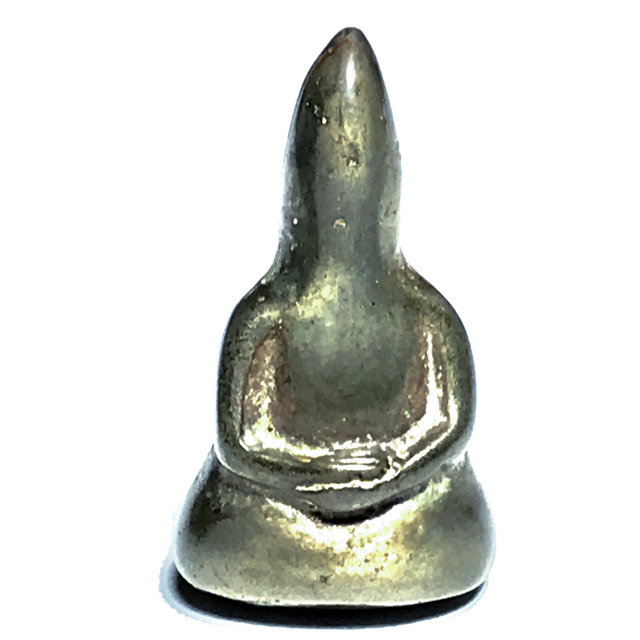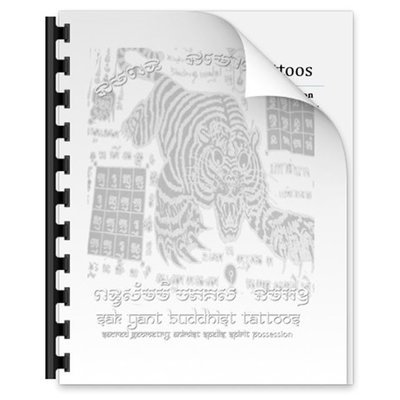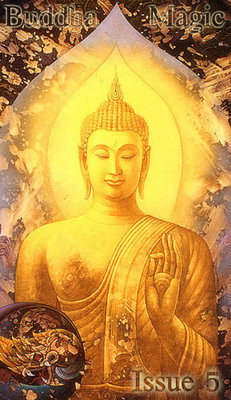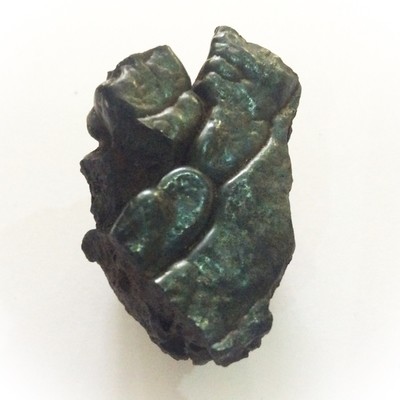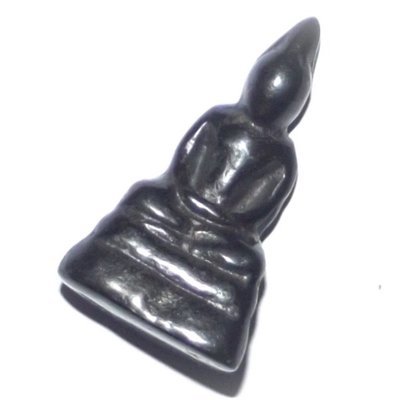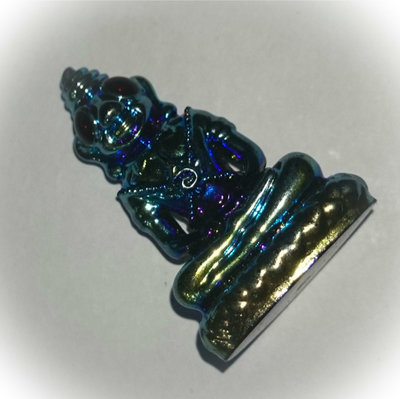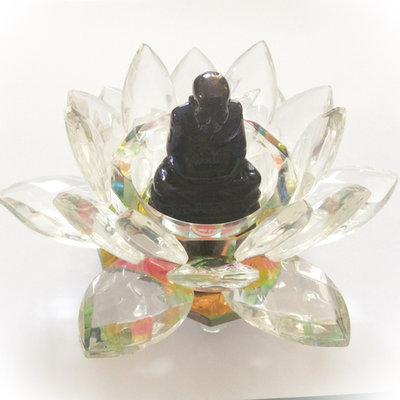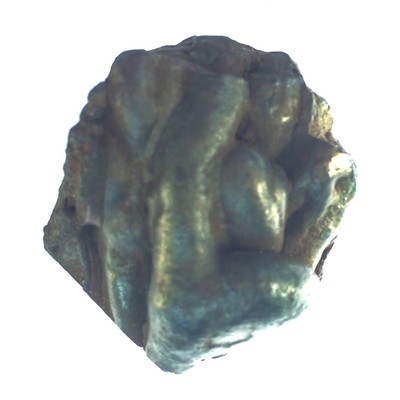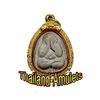

Thailand Amulets
Thai Buddhist and Magical amulets for Wealth, Health, Love and Happiness.
Vast Selection of Amulets
We have a vast selection of over 4000 different kinds of Sacred Amulets and Bucha Items, including Buddha Image, Loi Ongk statuettes, Buddhist Monk Coin Amulets, Takrut Charms, Nam Man Prai Oils, Mai Kroo Wands, Mitmor Ritual Knife, Lek Lai Kaya Siddhi Elemental Substance, Kumarn Tong, Gambling Amulets, Mae Nang Prai, Muan Sarn Sacred Powder Amulets, Palad Khik, Animist Charms, Necromantic Amulets, Buddhist, Animist, Brahman and Necromantic Amulets.
Pra Put See Tong Pla Hlai Gold-Green Lek Lai Buddha 2548 BE Luang Por Huan Wat Putai Sawan
Lek Lai Buddha in Samadhi Posture of Meditation, with golden-olivegreen tone of the highly preferred 'See Tong Pla Hlai Om Khiaw' color variety of Lek Lai Kaya Siddhi Elemental Substance, from Thailand's Top Master of Wicha Lek Lai, Luang Por Huan (Wat Putai Sawan). This extremely rare and interesting piece of Golden Lek Lai Kaya Siddhi Elemental Substance, was conjured into existence by the great master of Wicha Riak Lek Lai (the ability to call, and magically transform Lek Lai Kaya Siddhi Elemental Substance), Luang Por Huan, of Wat Putai Sawan.
Lek Lai See Tong Pla Hlai, is perhaps the least common, and most highly sought after Lek Lai for its beautiful appearance. See Tong Pla Hlai can be found with greenish, pinkish, purplish and blueish subtones within the golden sheen, depending on each exhibit. This exhibit has a greenish olive tone reflected in the golden Lek Lai.
Luang Por Huan's methods and his Magical Powers, have come to be world-famous, and common knowledge, that he is the current world's top Master Monk for controlling this extremely difficult to Master form of Buddha Magic.
It is believed, and said by many, that one must attain a spiritual and psychic connection with the 18 Siddhis, who inhabit the Lek Lai Kaya Siddhi Elemental Substance, in order to be able to call, control and transform the lek Lai. It was these 18 yogic sages, who first discovered and mastered the Wicha by creating an adamantine body of light, and sending their consciousness to dwell within it, and then sending that body of light, to dwell within the adamantine body of the Lek Lai Kaya Siddhi Elemental Substance. In addition to Mastering this ability to communicate with and convince the Siddhi within the Lek Lai, it is also said that only a Monk who is of Great Purity, can be able to call and transform the Lek Lai.
Lek Lai is said to possess many abilities and powers, one of them being the ability to disappear or melt and just trickle away into the earth and travel where it wants to, and stay with whom it wishes.
Lek Lai is also famous for refusing to stay with those who are not fitting to possess Lek Lai. So it is clear that only a Practitioner of High Purity of Renunciation and Powerful Mind, can be listened to by the Siddhis, amd convinced to transform and emerge from the nest deep within the rock walls of the Sacred Holy Cave.
You can differentiate the golden color of the Lek Lai see tong pla hlai against the other spheres of see peek malaeng tap in the above picture, which shows the Lek Lai see tong pla hlai on the top right of the group of spheres. Its gold-green-purplish tonality is eyecatching, and easy to differentiate.
The Lek Lai Was extracted from the wall of the holy cave, by the great master Luang Por Huan himself, using incantations and performing the rituals that were necessary to ask permission of the local deities and local spirits and to communicate with the entities within the Lek Lai Kaya Siddhi elemental substance.
It is Lek Lai Tham (cave lek Lai) which has been extracted using the ancient magical Wicha (some forms of Lek lai are manually extracted and do not possess the same super powers as that extracted by a pure hearted monk with powerful Wicha).
Lek Lai Tham

If there is any form of Lek Lai, or place where it is said that real Lek Lai should be found, it is the Cave. Before the Public Interest in Lek Lai began some years ago, Lek Lai was almost always assumed to come from caves in mountain forests. It is said that Lek Lai of the type found in caves can be stretched when heated, and coaxed into different forms.
This is done by anointing (bathing) the piece of Lek Lai in honey as it is still in its raw Mineral form, and then heating it under a powerful flame, until the Lek Lai hidden within it liquifies and runs out of the stone, to come and eat the honey. The Lek Lai is coaxed into dripping down in a thin long line, and then it is cut using a special consecrated cutting instrument, such as a Meed Hmor spirit knife. It is believed that it is not possible for any person to cut Lek Lai, for the Lek Lai is guarded over by the spirits and Devas of the Cave and the Forest, as well as the local Yaksa giants who protect it.
In addition, the spirit within the Lek Lai is extremely powerful and can harm the person who tries to cut it. It is said that the person who cuts the Lek Lai must not only learn the Wicha, but also have gathered enough Merit to be able to approach and cut the Kaya Siddhi. Whoever is lucky enough to receive the protection of Lek Lai, will be impossible to harm or kill with bullets, knives or other sharp instruments, and even explosions. Gunpowder or other such explosive materials can not come close to a piece of Lek Lai and are repelled by its Adamantine Nature. In addition, Lek Lai protects from poisonous animals such as Mambas, Cobras and the like.
Three types of Extract Lek Lai Tham is extracted and produced in three different forms, or states
1. Lek Lai (Pure Lek Lai) – this can be stretched and liquified under flame, and possesses extreme power.
2. Rang Lek Lai (Lek Lai nest) – This part of the extract is not as shiny and reflective as pure Lek Lai. It can not be melted or stretched under flame. It is the part which covers the Lek Lai on the wall of the cave like a shell, and is tightly stuck on the wall of the cave.
3. Khee Lek Lai (Lek Lai residues) – this part of the Lek Lai looks like dripping candle wax, and is very brittle and can be broken if it recieves a hard blow. This kind of lek Lai, if occurring in large amounts, is said to not be very powerful compared to pure Lek Lai and Rang Lek Lai.
Lek Lai is then given three different classification levels too
1. Lek Lai Nam Neung - top quality types, such as Lek Lai Bpeek Malaeng Tap, Lek Lai Jao Pha, Lek Lay Gotapee, Lek Lai Ngern Yuang, Lek Lai Chee Ba Khaw, Lek Lai Paetch Dam, and Lek Lai Tong Pla Hlai.
2. Lek Lai Nam Rong – medium level power and purity Lek Lai types such as Kote Lek Lai, Rae Go Larn, Rae Met Makham and Lek Lai Torahod.
3. Khee Lek Lai – the by product, or residue. Often used for making sacred powders as part of the mixture which is then pressed into powder amulets, also used in prayer water, and also placed on its own dais and worshiped on the altar, or carried as a Luck bringer and Protective elemental substance.

Luang Por Hone (actually called 'Huan' but is somehow internationally come to be known as as LP Hone), of Wat Putai Sawan is perhaps the most famous master of all in Modern times for his ability to summon and cut Lek Lai from within the stone walls of ancient caves, and to use his meditative skill and incantation mastery to charm and coax it along the sincana cords into his alms bowl, where it takes on different shapes and forms as amulets, which Luang Por Hone had pre-cast wax candles carved into the shape of the different amulets he wished to be formed. The Lek Lai then mimics the form of the wax effigies and begins to take shape as the wax melts within the alms bowl.

The Invocation and Manifestation if Lek Lai was achieved with Luang Por Hone performing the 'Piti Dtat Lek Lai' himself within the sacred cave. Once collected, it was then charmed into the shape of amulets in different forms and sizes, and given empowerments at Wat Puttai Sawan.
Piti Dtat Lek Lai
Before beginning anything else, Luang Por Hone would project his mind to seek out which cave the Paya Lek (Lek Lai) was residing in. Once he had determined with his psychic powers where the Lek Lai was, he would took some of his Devotees with him to the place and let them investigate, for all to see with their bare eyes what was there. After this, the selection of an Auspicious and safe date and time to perform the Ritual was chosen. Luang Por Hone said that a cave with Lek Lai present within it, will be a clean cave with no bats living inside it. In most cases, it will be a marble or granite cave with a cool soft smooth surface.
This kind of cave is sometimes even freezing cold inside. The cave will be dry and without moisture or inundation. Apart from the 'Krueang Buang Suang' (Offerings and Ritual Instruments) needed for the Ceremony, it is essential to have some pure Honey and Beeswax, which LP Hone had already prepared and brought along. The Devotees and entered the cave and sat to spectate as Luang Por Hone began to prepare to open the Ceremony.

Piti Buang Suang – Reverence and Offerings to the Local Devas
The offerings were arranged and ceremonial incantations performed in a very similar way as performed in the preamble to Puttapisek and Wai Kroo ceremonies. The ceremony and offerings serves the purpose of informing and asking permission of the Jao tee Jao tang (Local Devas) and the Spirit of the Cave which guards the Lek Lai, that the Lek Lai is to be taken and used for the benefit of the Buddha Sasana
(For a detailed description of which offerings are used in such a ceremony, we recommend reading Ajarn Spencer Littlewood's first ever Ebook 'Sak Yant Buddhist Tattoos').
After the Piti Buang Suang was completed, Luang Por Hone focused his mind and applied the Wicha which he learned from his Lineage Masters and developed with meditation. He continued until he had raised the correct psychic energy within his mind to perform the next step.
Then he took the pure wild honey, and smeared it on the crevices of the cave, anointing the cracks in the walls of the cave, chanting Kata Akom the whole time as he anointed the walls of the cave with honey. He chanted the whole time until the walls are anointed with honey, and then stands and closes his eyes, remained very silent and focused his psychic powers. The Devotees present in the cave were then able to witness something miraculous; Along the cracks and crevices of the cave, a substance had begun to ooze out as if attracted by the honey which Luang Por Hone had smeared along the crevices of the cave. Luang Por Hone then took his 'Sai Siin' (Sinjana Cords – a thin white cord used in Buddhist rituals), which he had previously soaked in honey, and inserted one end of the cord into the crevice which he had anointed with honey, and then brought the other end of the cord to fall down from the wall of the cave into the 'Badtr Nam Montr (large almsbowl normally used as a prayer water receptacle).
The Badtr Nam Mont contained a generous coating beeswax, and a white cloth covered with Sacred Yantra Inscriptions covered the Badtr Nam Montr. Only a small hole in the white cloth which covered the alms bowl allowed the Sai Siin cord to pass through into the bowl. This is the method to trap the lek Lai, by enticing it to travel along the cord eating honey along the way, until it ends up inside the alms bowl. Because of the magical spells written on the Pha Yant (Yantra cloth), the Lek Lai cannot escape and return to the wall of the cave. Once Luang Por had inserted the cord through the Yant cloth into the Badtr Nam Montr, he took the candles he had made especially for this ritual using the pure wild beeswax, and rolled the flame of the candle along the wall of the cave, illuminating the wall where the Lek Lai was flowing out. As he did this, he constantly performed Incantations of Kata Akom to coax the Lek Lai to travel along the Sai Siin cords to consume honey inside the Badtr Nam Montr.
There were three different colored Lek Lai which dribbled down into the Badtr Nam Montr; 'See Maekapat' (a dark blue-green metallic color), 'See Ngern Yuong' (molten silver color) and 'See Tong Pla Hlai' (golden brown color). The color changes depending on what kind of Lek Lai it is that is present in the cave.
Most of the Lek Lai types which Luang Por Hone will call is the blue-green See Pek Malaeng Tap, or 'See Maekapat', and the molten silver colored 'Ngern Yuong' types, for he says these two types are able to be shared and distributed to the laypersons and devotees easily. But he does not prefer to give the Lek Lai See Tong Pla Hlai of golden brown color to those who come to make merit, because it has very strong magic within it, which can affect the person wearing or carrying it to become very arrogant and cause much disturbance and problems both for others and for themselves.
Once the Lek Lai had traveled along the Sinjana cords into the alms bowl whilst still in liquid form), Luang Por Hone took it to perform the next ritual act, namely to induce the Lek Lai to solidify. He took the Badtr Nam Montr, and placed it on top of a fireplace. He then took the bees wax, which had been carved and formed into various shapes and images which are spells to communicate to the liquid Lek Lai in the alms bowl that it should form itself into different shapes and forms to become these Pelletsm as well as other forms, such as Luabng Phu Tuad, Pra Sonmdej, and other Buddha amulets.

Above Pic; 'Lek Lai Hung' - Lek Lai charmed into shape using wax effigies to communicate the forms which the Lek Lai should assume.
The different forms of amulets manifested
Some of the forms created were Pra Kring, Pra Somdej, Luang Por Tuad, and Buddha images. Other shapes such as a rugby ball shape and smaller shapes for insertion into other amulets were also made. The wax shapes have a 'Sai Chanuan' (wick), like the Tian Chai Victory candles seen in Putta Pisek Ceremonies. This is in order to ignite and heat the receptacle for the Invocation of the Lek Lai to take form and shape itself into amulets. Luang Por then lit the wick of the brazier and began his Incantations, as the wax melted in with the still liquid form Lek Lai in the alms bowl. As the wax became runny, the liquid Lek Lai began to congeal and emerge in solid form, Miraculously appearing in different shapes and forms.
The Lek Lai transformed into exactly the same shape as the carved wax effigies which had been melted down in the alms bowl with the Lek Lai (Pra Kring, Pra Somdej, Pra Nang Paya, Pra Sum Gor, a few Pra Luang Phu Thuad, and other shapes. The amulets that emerged were much smaller than the original wax effigies melted down in the alms bowl. The Lek Lai were of different colors with strange and wonderful auras to them, glinting different colors under different light. Once all of the Lek Lai had formed itself into amulets, Luang Por took them and performed 'Piti Suad Yadti'.

Above; Lek Lai in Torpedo and Somdej shape which was conjured during the Ritual. This Ritual is a binding spell to prevent the Lek Lai from changing back into its original fluid form, or escape back to its lair. After this, Luang Por would make further Incantations (Pluk Sek), and then he handed out some of the Lek Lai amulets to the Devotees who had attended and made Merit. Left; Mysterious Emergence of Lek Lai Taat Gaayasit . As the bees wax of the candle melts, the Lek Lai somehow appears from within and begins to emerge, slowly taking form and shape. This image was recorded by the Ounamilit Team of Paranormal Documentalists. This method of creating Lek Lai amulets is called 'Piti Hung Lek Lai'.

There are 7 Major colors of Lek Lai;
See Khiaw Bpeek Malaeng Tap/Maekapat (black-blue)
See Nam Dtaan Orn (light brown)
See Plueak Mangkut (magenta)
See Ngern Yuong (silvery color like mercury)
See Tong Pla Hlai ( Eels-Belly Golden color)
See Nam Nom (Nam Nom Phaen Din – creamy Ivory white)
See Phasom (4 major colors mixture, or 7 colors/Lek Lai jet See)

The Qualities of Lek Lai
It resides within the walls of caves that are cool and damp, with no bats living in there.
It can remain in a static form.
It can slither and move like a snake.
It can appear from nowhere.
It can disappear.
It can stretch itself
It can condense itself
It can block any energy fields, waves or frequency channels.
Guns will not fire in the presence of Lek Lai.
It can make hot water become cold in an instant.
It consumes the phosphorous of bullets and gun shells.
It can emit a Fragrant Aroma.
It can heal illnesses or injuries if laid on the place that is affected.
It is Magnetic.
It can become lighter or heavier.
It can be thrown and will fly back like a boomerang.
The subject of Lek Lai and all the different kinds in existence is one of the topics explained in Buddha Magic Issue 5

Kata Lek Lai- How to Worship Lek Lai Taat Gaayasit (Kaya Siddhi)
Lek Lai – is a Mysterious Sacred substance which is the subject of Legendary Tales of Miracle Powers which has become a Cult Phenomenon in recent years, due to the ease of access to information enabled by modern Media such as the internet, as well as being due to Marketing scams. Lek Lai used to be presented in only a few forms, shapes and sizes. Now however, there are literally hundreds of different looking substances which those who believe in this elusive miracle substance consider to be Lek Lai, or Lek Lai derivatives. Lek Lai has been used as an ingredient for mixing into amulets for centuries, as well as being used as a magical element in its own right.
Bucha method when Inviting Lek Lai into the Home
Light 12 Incense sticks, and inform the Local Deities and Ghosts about your intentions, and ask their blessing and to protect the household. Bai Sri cones, or, if not available, flower offerings. Honey offerings (one small glass can be placed to the side of the Lek Lai, you don’t have to immerse the Lek Lai in the honey). Perform Bucha Ceremonial Offerings every Full Moon, and lay the Lek Lai out to bathe in the Moonlight, to increase the power of the Lek Lai, and then feed it honey.
Kata Anchern lek Lai
(Kata for asking the Lek Lai to allow you to take it and wear it with you – from ‘Jao Khun Pra Putai Sawan Worakun, or, Luang Por Hone, of Wat Putai Sawan).
Na Mo Dtassa Pakawadto Arahadto Sammaa Samputtassa (3 times)
-
Puttang Aaraatanaanang Tammang Aaraatanaanang Sangkang Aaraatanaanang
-
Na Mo Puttaaya Na Ma Pa Ta Ja Pa Ga Sa Na I A Ta A Na I – Idtipiso Pakawaa Ji Bi Sae Dti Jijeruni Ma A U
Then make your prayer, or wish.
Kata Bucha Lek Lai – for Praying to the Kaya Siddhi
(Kata for incantation in the home or when carrying Lek Lai)
-
Putto Mae Naa Tho, Tammo Mae Naa Tho, Sangko Mae Naa Tho
-
Sa Ga Pa Ja Bucha Ja
I pay reverence to the guardian of the Sacred Element of Lek Lai that wields
great power.
-
I Sa Waa Su I Dti Bpi So Pa Ka Waa
Lek Lai, please grow and prosper,prosper greatly, cultivate good things and let them flow towards me.
Samma Sammaa Sammaa Samma Ma A U
Na Ma Pa Ta Na Mo Put Taa Ya
The subject of Lek Lai and all the different kinds in existence is one of the topics explained in Buddha Magic Issue 5
What are the properties of Lek Lai like?
1. Lek Lai has an oily shiny surface and reflects the light.
2. It displays many tones and color variations, and is astonishingly beautiful.
3. It looks transparent when immersed in water.
4. There is the Mind of a Ruesi of Great Power within it.
5. If the Ruesi leaves the Lek Lai, it becomes dark black-blue and opaque.
6. If the Spirit of the Ruesi is not present in the Lek Lai, it will not turn transparent and glassy when immersed in water.
There are 7 Major colors of Lek Lai;
See Khiaw Bpeek Malaeng Tap (black-blue)
See Nam Dtaan Orn (light brown)
See Plueak Mangkut (magenta)
See Ngern Yuong (silvery color like mercury)
See Tong Pla Hlai ( Eels-Belly Golden color)
See Nam Nom (Nam Nom Phaen Din – creamy Ivory white)
See Phasom (4 major colors mixture, or 7 colors/Lek Lai jet See)
The Qualities of Lek Lai
- It resides within the walls of caves that are cool and damp, with no bats living in there.
- It can remain in a static form.
- It can slither and move like a snake.
- It can appear from nowhere.
- It can disappear.
- It can stretch itself
- It can condense itself
- It can block any energy fields, waves or frequency channels.
- Guns will not fire in the presence of Lek Lai.
- It can make hot water become cold in an instant.
- It consumes the phosphorous of bullets and gun shells.
- It can emit a Fragrant Aroma.
- It can heal illnesses or injuries if laid on the place that is affected.
- It is Magnetic.
- It can become lighter or heavier.
- It can be thrown and will fly back like a boomerang.
Taat Gayasit (Kaya Siddhi Dhatu - Element of the Siddhis/Supernatural Element), is the Thai name for Adamantine Deity inhabited Elemental Substance, of which Lek Lai is included under this category. "Taat' (Dhatu) means element. "gayasit" means Body of the Sisddhis, or, alternatively "Supernatural". The Siddhis are therefore the root meaning of the word 'lek Lai Taat Gayasit'
Who or What are the Siddhis?
Siddhis are what practitioners believe to be spiritual, magical, paranormal, or supernatural powers acquired through sadhana (spiritual practices), such as meditation and yoga. People who have attained this state are formally known as siddhas.
Siddhi is a Sanskrit noun which can be translated as "perfection", "accomplishment", "attainment", or "success". In Tamil the word Siddhar/Chitthar refers to someone who has attained the Siddhic powers & knowledge. Chith is pure consciousness/knowledge in Sanskrit also.
The earliest appearance in Indian history of the idea that magical powers (Pāli iddhi) are generated by spiritual practices, (Pāli jhāna - Japanese; 'Zen'), is the account that appears in the Buddhist canon, in the [Sāmaññaphalasutta] of the [Dīghanikāya].
The term siddhi is later found in the Mahabharata. As a term in the Manusmriti, the Laws of Manu, it refers to the settlement of a debt.
Eight primary siddhis
In Hinduism eight siddhis (Ashta Siddhi) are known:
- Aṇimā: reducing one's body even to the size of an atom
- Mahima: expanding one's body to an infinitely large size
- Garima: becoming infinitely heavy
- Laghima: becoming almost weightless
- Prāpti: having unrestricted access to all places
- Prākāmya: realizing whatever one desires
- Iṣṭva: possessing absolute lordship
- Vaśtva: the power to subjugate.
Five siddhis of yoga and meditation
In the Bhagavata Purana, the five siddhis of yoga and meditation are:
- tri-kāla-jñatvam: knowing the past, present and future
- advandvam: tolerance of heat, cold and other dualities
- para citta ādi abhijñatā: knowing the minds of others and so on
- agni arka ambu viṣa ādīnām pratiṣṭambhaḥ: checking the influence of fire, sun, water, poison, and so on
- aparājayah: remaining unconquered by others
Ten secondary siddhis
In the Bhagavata Purana, Lord Krishna describes the ten secondary siddhis as:
- anūrmi-mattvam: Being undisturbed by hunger, thirst, and other bodily appetites
- dūra-śravaṇa: Hearing things far away
- dūra-darśanam: Seeing things far away
- manaḥ-javah: Moving the body wherever thought goes (teleportation/astral projection)
- kāma-rūpam: Assuming any form desired
- para-kāya praveśanam: Entering the bodies of others
- sva-chanda mṛtyuh: Dying when one desires
- devānām saha krīḍā anudarśanam: Witnessing and participating in the pastimes of the gods
- yathā sańkalpa saḿsiddhiḥ: Perfect accomplishment of one's determination
- ājñā apratihatā gatiḥ: Orders or commands being unimpeded
Samkhya
In the Samkhya Karika and Tattva Samasa there are references to the attainment of eight siddhis by which one becomes free of the pain of ignorance, one gains knowledge, and experiences bliss. The eight siddhis hinted at by Kapila in the Tattvasamasa[note 2] are as explained in verse 51 of Samkhyakarika:
Uuha: based on the samskaras of previous births, the attainment of knowledge about the twenty-four Tatwas gained by examining the determinable and the indeterminable conscious and the non-conscious constituents of creation,
Shabad: knowledge gained by associating with an enlightened person (Guru – upadesh),
Addhyyan: knowledge gained through study of the Vedas and other standard ancillary texts,
Suhritprapti: knowledge gained from a kind-hearted person, while engaged in the spread of knowledge
Daan: knowledge gained regardless of one’s own needs while attending to the requirements of those engaged in the search of the highest truth,
Aadhyaatmik dukkh-haan: freedom from pain, disappointment, etc. that may arise due to lack of spiritual, metaphysical, mystic knowledge and experience,
Aadhibhautik dukkh-haan: freedom from pain etc. arising from possessing and being attached to various materialistic gains,
Aadhidaivik dukkh-haan: freedom from pain etc. caused by fate or due to reliance on fate,
The attainment of these eight siddhis renders one no longer in a painful state of ignorance but in possession of greater knowledge and experience of bliss. The aim of Samkhya is to eliminate all kinds of physical and mental pains and to receive liberation.
Patanjali's Yoga Sutras
In Patanjali's Yoga Sutras IV.1 it is stated:
janma auṣadhi mantra tapaḥ samādhijāḥ siddhayaḥ
In translation:
Accomplishments may be attained through birth, the use of herbs, incantations, self-discipline or samadhi.
Hindu gods associated with gaining siddhi
In Hinduism, both Ganesha and Hanuman possess the eight supernatural powers (ashtamahasiddhis) and can give one access to Ashta Siddhis.
Usage in Vajrayana Buddhism
In Tantric Buddhism, siddhi specifically refers to the acquisition of supernatural powers by psychic or magical means or the supposed faculty so acquired. These powers include items such as clairvoyance, levitation, bilocation, becoming as small as an atom, materialization, having access to memories from past lives. The term is also used in this sense in the Sarva-darśana-saṃgraha of Madhvacharya (1238–1317).
The 18 Siddhars
Sri Agasthiyar
Sri Agasthiyar is one of the 18 yoga siddhas who have initiated many siddhas including kriya guru Babaji. He was initiated directly by Lord Shiva himself and his works include medicine, kaya kalpa, Tamil grammar and yoga. Some of his disciples are Boganathar, Babaji, Thiruvalluvar, Macchamuni. He has attained samadhi at Ananthasayana.
Sri Nandi Devar
Nandi Devar is one of the foremost of the 18 yoga siddhas. He has been directly initiated by Lord Shiva himself and some of his contributions include medicine, kaya kalpa & Alchemy. Some of his eminent disciples are Thirumoolar, Patanjali, Dakshinamoorthy, Romarishi (Kayilay Kambilisattamuni) & Sattaimuni.
Sri Thirumoolar
Thirumoolar is one of the 18 yoga siddhas. He has been initiated by Nandi Devar and his contributions include works in yoga and philosophy. His 'Thirumandiram' work is very popular among his works. He has attained samadhi in Chidambaram.
Sri Bogar
Bognathar who is also known as the Palani Malai Siddhar is one among the 18 yoga siddhas. He was initiated by Kalanginathar and Agastyar. He is a great alchemist of all times. His contributions include yoga, kaya kalpa, medicine, alchemy, natural sciences, philosophy etc. He is the one who has created and installed the idol of Lord Muruga in Palani malai temple. Till now even after ages, the composition of the idol has been a mystery to all scientists around the world. His disciples include Babaji, Konkanavar, Karuvoorar, Pulipani and Idaikadar.
Sri Konkanavar
Konkanavar is one of the 18 yoga siddhas initiated by Boganathar. His contributions include 25 known works in medicine, yoga, philosophy, religion etc. He has over 557 disciples. He has attained samadhi at Tirupati.
Sri Machamuni
Machamuni who is also known as Matsyendranath is one of the 18 yoga siddhas. He has been initiated by Agasthiyar, Punnakeesar and Pasundar. Some of his contributions include 10 known works on Hatha yoga, Tantric yoga practices etc. Gorakhnathar is one of his eminent disciples. He has attained samadhi at Thiruparrunkundram.
Sri Gorakhnathar (Gorakkar)
Gorakhnathar is one of the 18 yoga siddhas in the 'nath' tradition. He was initiated by Dattatreya (Vishnu), Macchamuni and Allama Prabu. Some of his contributions include "Avadhuta Gita" and 13 other works, order of ascetics, medicine, alchemy, Hatha Yoga Pradipika classic etc. He has attained samadhi at Poyur (Girnar).
Sri Sattaimuni
Sattaimuni is one of the 18 yoga siddhas and was initiated by Nandi Devar & Dakshinamoorthy. His contributions include 46 known works in medicine, alchemy & etc. His disciples include Sundaranandar and Paambatti. He has attained samadhi at Srirangam.
Sri Sundaranandar
Sundaranandar is one of the 18 yoga siddhas. He was initiated by Sattaimuni & Konkanavar. Some of his contributions include 24 known works: medicine, philosophy etc. He has attained samadhi at Kudal (Madurai).
Sri Ramadevar (Yacob)
Ramadevar is one of the 18 yoga siddhas. He was initiated by Pulastiyar and Karuvoorar. He is also known as the mandira siddhar. Some of his works include 24 known works: mantra shastra, medicine etc. He has attained samadhi at Alagar Malai.
Sri Kudambai
Kudambai is one of the 18 yoga siddhas, initiated by Alukkani Siddha (disciple of Idai Kadar). Kudamabi siddhar's contributions included siddha philosophy. His place of samadhi has been Mayavaram.
Sri Karuvoorar
Karuvoorar is one of the 18 yoga siddhas. He was one of the eminient disciples of Bhoganathar after being initiated by him. He is popular for his contribution in constructing the Tanjore temple and other medicinal works. IdaiKadar is one of his eminent disciples. He has attained samadhi at Karuvai (karur).
Sri Idaikadar
Idaikadar is one of the 18 yoga siddhas. He was initiated by both Bhoganathar and Karuvoorar. His contributions include two known works in kaya kalpa. He attained samadhi at Thiruvannamalai. Some of his disciples are Kudambai and Alukkani.
Sri Kamalamuni
Kamalamuni is one of the 18 yoga siddhas. He has attained samadhi at Aarur (Tiruvarum). His contributions include two known works on medicine and philosophy.
Sri Valmiki
Valmiki is one of the 18 yoga siddhas. He was initiated by the great sage Narada. He is very much known for recording the epic work 'The Ramayana'. He has attained samadhi at Ettikudi.
Sri Pathanjali
Pathanjali is one of the 18 yoga siddhas. He was initiated by Nandi Devar. He is known for his works on yoga sutras classic. He has attained samadhi at Rameswaram. He is also known as father of yoga.
Sri Dhanvanthri
Dhanvanthri is one of the 18 yoga siddhas. He is known for his contributions on medicine, alchemy, kaya kalpa, 22 known works. He has attained samadhi at Vaideeswaran Kovil.
Sri Pambatti (Paambatti)
Pambatti is one of the 18 yoga siddhas. He was initiated by Sattaimuni. His contributions includeworks in siddha philosophy. He has attained samadhi at Harisankaran kovil. He was originally a snake charmer before he met his guru Sattaimuni. Later after being initiated by his guru, due to his intense sadhana he has became a siddha.
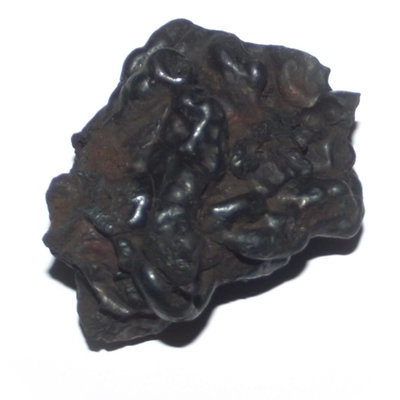
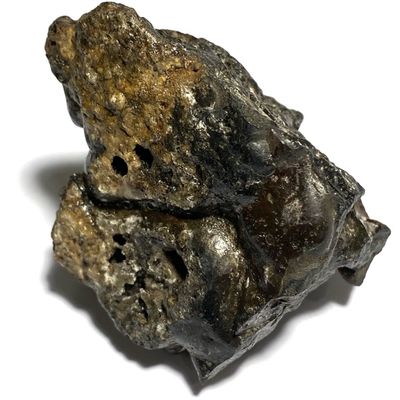
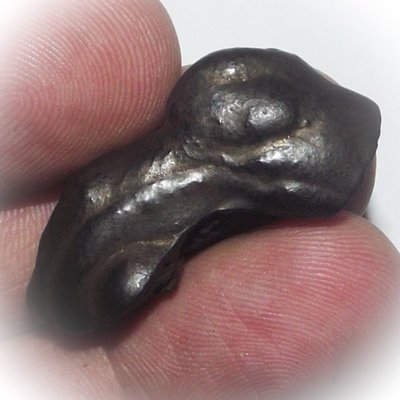
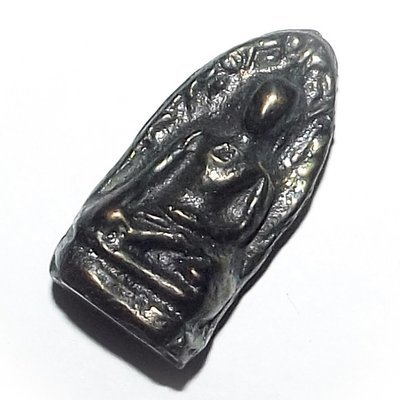
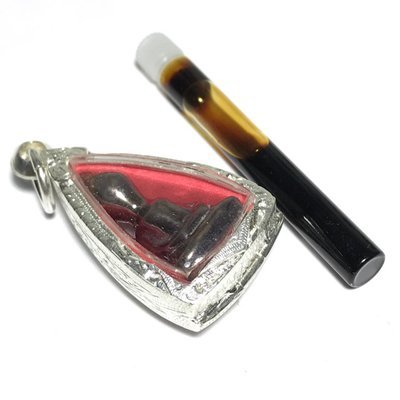
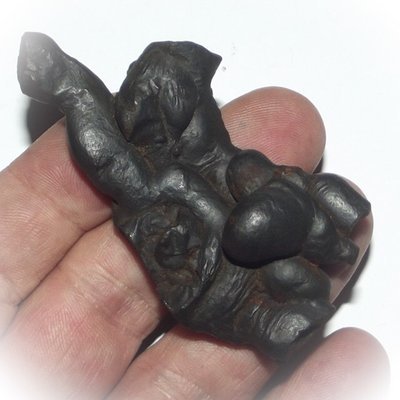
Contact Us
Follow Us on Youtube
About Us
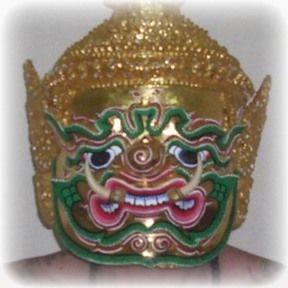
Ajarn Spencer
Proprietor
Thailand Amulets is owned and Administrated by Thai Occult and Amulet expert, Ajarn Spencer Littlewood who guarantees only authentic blessed amulets, and a free gift with every order, as well as his safe delivery or money back guarantee. https://facebook.com/ajarnspencer
